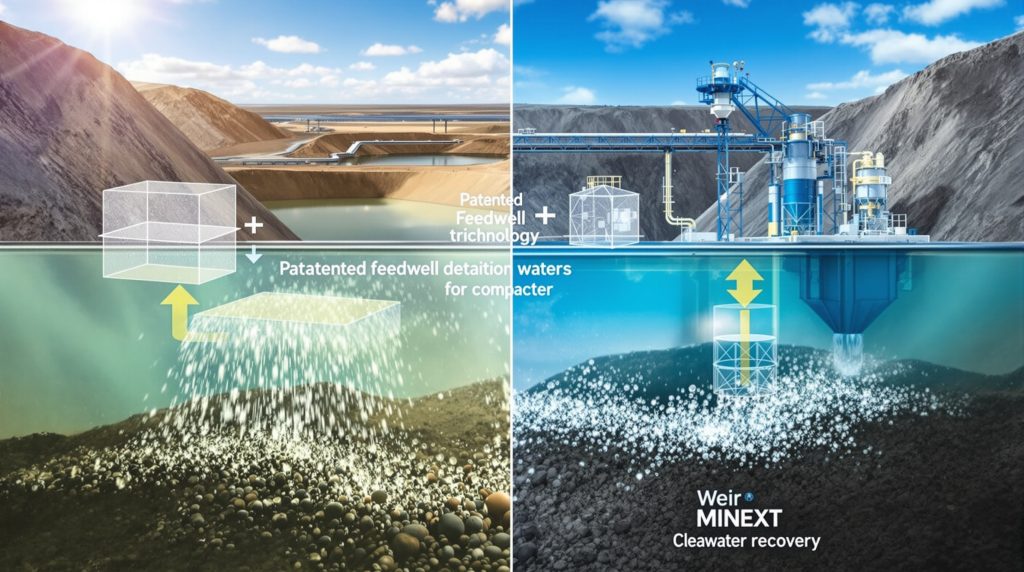Revolutionizing Tailings Management: Weir and MINEXXT Redefine Mining Waste Solutions
The mining industry faces intensifying scrutiny regarding waste management practices, with traditional tailings facilities increasingly viewed as environmental liabilities. The recent strategic collaboration between Weir and MINEXXT marks a significant advancement in addressing these challenges through innovative thickening technology. This partnership aims to transform how mining operations handle waste materials, with far-reaching implications for environmental protection, water conservation, and operational efficiency.
The collaboration integrates MINEXXT's specialized feedwell technology into Weir's global tailings solutions portfolio, creating a comprehensive approach to one of mining's most persistent challenges. With initial projects already underway in Australia and Kazakhstan, the partnership signals a new era in sustainable mining transformation across the global mining sector.
The Growing Challenge of Mine Tailings Management
Mining operations worldwide generate massive volumes of waste material, with the global mining industry producing an estimated 14 billion tonnes of tailings annually. Traditional tailings storage facilities increasingly face scrutiny due to safety concerns, environmental impacts, and resource inefficiency. Recent catastrophic tailings dam failures have heightened awareness of the risks associated with conventional storage methods, driving regulatory changes and industry initiatives.
Modern mining requires innovative solutions that can reduce water usage, minimize environmental footprints, and enhance the stability of stored waste materials. With many operations processing lower-grade ores, the volume of waste material continues to grow, creating urgency for more sustainable approaches.
The industry's water usage presents another critical challenge. Mining operations typically consume between 500 and 1,000 liters of water per tonne of ore processed, with a significant portion lost in conventional tailings disposal. This consumption becomes particularly problematic in water-scarce regions where mining activities compete with agricultural and community needs for limited water resources.
The MINEXXT Feedwell Technology: Engineering Innovation
MINEXXT's patented feedwell technology represents a significant advancement in thickening processes essential for effective tailings management. The system optimizes the separation of solids from liquids in mining slurries through several innovative mechanisms:
Advanced Flocculation Management
The MINEXXT system utilizes precision-engineered flocculation zones that optimize flocculant mixing and residence time. This ensures maximum particle aggregation efficiency while minimizing flocculant consumption—a critical advantage considering that flocculants can represent a significant operational expense in tailings management.
Enhanced Particle Settling Dynamics
The technology employs controlled flow patterns that create ideal settling conditions even for problematic fine and ultra-fine particles. This addresses one of the most persistent challenges in conventional thickening operations where ultra-fine particles often resist settling and cause downstream processing issues.
Water Recovery Performance
Unlike conventional systems that struggle to achieve optimal water recovery, the MINEXXT technology significantly improves this critical metric through more efficient solid-liquid separation. This directly translates to reduced freshwater consumption and lower overall environmental impact.
Technical Performance Comparison
The performance advantages of the MINEXXT technology become clear when compared with traditional systems:
| Performance Metric | Traditional Systems | MINEXXT Technology | Benefit |
|---|---|---|---|
| Water Recovery | 60-70% | 80-90% | Reduced freshwater consumption |
| Ultra-fines Handling | Limited efficiency | Specialized design features | Better waste stability |
| Operational Flexibility | Fixed parameters | Adaptable to varying conditions | Consistent performance despite feed variations |
| Energy Efficiency | Higher power requirements | Optimized energy consumption | Lower operational costs |
| Maintenance Needs | Frequent intervention | Reduced mechanical complexity | Improved uptime and reliability |
Global Implementation and Expansion Strategy
The Weir-MINEXXT partnership has begun demonstrating practical applications of this advanced technology through carefully selected initial projects.
Australia: Complex Mineral Challenges
In Australia, implementation focuses on operations dealing with challenging mineral compositions typical of the region's diverse mining sector. The country's mature mining industry, combined with stringent environmental regulations and water scarcity concerns, makes it an ideal proving ground for advanced tailings solutions.
The Australian projects specifically target operations processing fine-grained ores with high clay content—materials that traditionally create significant challenges for conventional thickening systems. These implementations serve as reference sites demonstrating the technology's effectiveness under demanding conditions.
Kazakhstan: Extreme Environment Applications
The Kazakhstan implementations address mining environments with specific geographical and operational constraints, including extreme temperature variations and remote locations. These conditions test the technology's robustness and adaptability, demonstrating its viability across diverse mining contexts.
These initial projects establish a foundation for wider adoption across global mining regions, with particular focus on:
- Operations in arid regions where water recovery represents a critical operational and environmental priority
- Mines facing increasingly stringent regulatory requirements regarding tailings management
- Projects processing complex ore bodies that produce problematic tailings with high percentages of ultra-fine particles
Environmental Benefits: Beyond Compliance
The advanced thickening technology delivers environmental benefits that extend beyond mere regulatory compliance, representing genuine progress toward more sustainable mining practices.
Water Conservation Impact
By significantly improving water recovery from tailings, the technology directly addresses one of mining's most significant environmental challenges. Conventional tailings facilities can lose up to 40% of process water through seepage and evaporation. The enhanced thickening technology can recover up to 90% of water for recycling back into the processing circuit.
For a typical medium-sized operation processing 50,000 tonnes of ore daily, this improvement can translate to water savings of over 1 million cubic meters annually—equivalent to the water consumption of a small city.
Reduced Storage Footprint
The technology produces higher-density tailings that require significantly less storage space than conventional methods. This directly translates to smaller tailings facilities with reduced land disturbance—a critical advantage in environmentally sensitive areas or regions where available land is limited.
The more compact storage requirements also mean less material that requires long-term management, reducing closure and rehabilitation costs while minimizing the operation's overall environmental legacy. This approach aligns with modern mine reclamation evolution principles that emphasize minimizing environmental impacts throughout the mining lifecycle.
Enhanced Material Stability
The improved dewatering efficiency creates tailings with greater structural stability, significantly reducing the risk of containment failures. This addresses one of the most serious environmental risks associated with mining operations, as evidenced by recent catastrophic tailings dam failures that have had devastating environmental consequences.
Key Leadership Perspectives on the Partnership
The collaboration brings together expertise from both organizations, with leadership expressing aligned visions for transforming tailings management:
Erik Vlot, Weir Global Tailings Process Director, emphasizes the critical role of advanced thickening in future tailings management: "Thickening will remain important as part of tailings flowsheets and the challenge around thickening of fines and ultra fines can be addressed with MINEXXT patented feedwell technology."
Mike Cook, MINEXXT Managing Director, highlights the value of collaborative innovation: "Collaborating allows innovative companies such as Weir and MINEXXT to access a broader, more knowledgeable resource pool… enabling us to offer clients a proven, and more practical solution for optimising their operations."
This alignment between technical innovation and practical implementation expertise creates a powerful combination for addressing complex tailings challenges across diverse mining operations.
Technical Challenges Addressed Through Collaboration
The partnership specifically addresses several persistent technical challenges that have historically limited the effectiveness of tailings management systems.
Ultra-Fine Particle Management
One of the most significant challenges in modern tailings management involves handling increasingly fine particles resulting from more intensive ore processing methods. As mining operations process lower-grade ores, grinding circuits produce finer particles to achieve adequate mineral liberation.
These ultra-fine particles, often below 10 microns in size, create specific challenges:
- They resist conventional thickening approaches due to low settling velocities
- When deposited, they create poorly consolidated layers in tailings facilities
- They retain excessive water, complicating dewatering efforts
- They can remain suspended in process water, causing downstream issues
The MINEXXT technology specifically targets these problematic materials through:
- Optimized flocculation zones that enhance particle aggregation
- Flow patterns designed to maximize settling of even the smallest particles
- Specialized internal geometry that prevents short-circuiting and ensures consistent performance
Integration with Existing Systems
The collaboration emphasizes practical implementation within real-world mining operations, addressing the critical challenge of integrating new technology with existing infrastructure. Key aspects include:
- Retrofit capabilities allowing installation within operational facilities with minimal disruption
- Scalable designs suitable for operations ranging from small to world-class
- Adaptability to different ore types and processing methods through customizable features
- Compatibility with existing digital control systems and monitoring networks
This practical approach to implementation recognizes that technological innovation must be accessible and adaptable to deliver real-world benefits across diverse mining operations.
Alignment with Industry Sustainability Trends
The mining industry faces mounting pressure to improve environmental performance while maintaining economic viability. This collaboration addresses several key industry trends that are reshaping mining operations worldwide:
Water Stewardship Initiatives
Water management has become a defining issue for the mining industry, particularly in regions experiencing increasing water stress. The International Council on Mining and Metals (ICMM) has established water stewardship as a core principle for sustainable mining, with member companies committing to measurable improvements in water efficiency.
The enhanced water recovery capabilities of the Weir-MINEXXT technology directly support these initiatives by:
- Reducing freshwater withdrawal requirements
- Minimizing wastewater discharge volumes
- Improving water recycling rates within processing circuits
- Enhancing water accounting and reporting capabilities
Energy Efficiency and Emissions Reduction
Mining operations face increasing pressure to reduce energy consumption and associated greenhouse gas emissions. The tailings management system addresses this challenge through:
- Lower energy requirements for pumping due to reduced water volumes
- Decreased carbon footprint from reduced water treatment needs
- More efficient mechanical systems that require less power
- Optimized processes that minimize energy-intensive rework
This focus on energy efficiency complements broader efforts toward electrification in mining operations, creating a more comprehensive approach to reducing environmental impacts.
Global Tailings Standard Compliance
Following the 2019 release of the Global Industry Standard on Tailings Management, mining companies face new requirements for tailings facility design, management, and monitoring. The collaboration's technologies align with these standards by enhancing:
- Tailings physical and chemical stability
- Water management effectiveness
- Monitoring and control capabilities
- Risk reduction throughout the tailings lifecycle
Economic Benefits for Mining Operations
Beyond environmental advantages, the technology offers several economic benefits that enhance the business case for implementation:
Operational Cost Advantages
The technology delivers measurable cost reductions across several operational areas:
- Water procurement savings: Reduced freshwater requirements translate to lower acquisition costs, particularly significant in water-scarce regions where water rights can be expensive.
- Energy cost reduction: More efficient dewatering processes require less pumping energy, while higher-density tailings reduce transport power requirements.
- Chemical savings: Optimized flocculant use reduces chemical consumption, often by 15-25% compared to conventional systems.
- Land utilization improvement: Smaller tailings footprints reduce land acquisition and preparation costs.
Long-term Financial Benefits
The implementation of advanced tailings solutions contributes to improved long-term financial performance through:
- Reduced closure liabilities: More stable, compact tailings facilities require less extensive closure works and ongoing monitoring.
- Lower regulatory compliance costs: Systems aligned with evolving regulations reduce the need for costly retrofits or operational changes.
- Decreased environmental risk: Reduced likelihood of costly environmental incidents and associated remediation expenses.
- Enhanced social license: Improved environmental performance supports continued operational approvals in sensitive regions.
For a typical mid-sized mining operation, these combined benefits can represent millions of dollars in annual savings and risk reduction. Furthermore, considering natural capital in mining operations, these solutions help companies better account for and preserve environmental assets.
Implementation Methodology
The implementation of these advanced tailings solutions follows a structured approach designed to maximize effectiveness while minimizing operational disruption:
Assessment and Design Phase
The process begins with comprehensive site assessment, including:
- Material characterization: Detailed analysis of tailings physical and chemical properties
- Process evaluation: Review of existing tailings systems and identification of integration points
- Performance benchmarking: Establishment of baseline metrics for comparison
- Site-specific design: Development of customized solutions based on operational requirements
Installation and Commissioning
The physical implementation typically follows a phased approach:
- Pre-installation preparation: Site modifications and infrastructure preparation
- Equipment delivery and installation: Often scheduled during planned maintenance windows
- Integration with control systems: Connection with existing monitoring and control networks
- Commissioning and testing: Gradual ramp-up with performance verification
Optimization and Knowledge Transfer
Following installation, the focus shifts to optimization and capability building:
- Performance fine-tuning: Adjustment of operational parameters to maximize effectiveness
- Operator training: Comprehensive education on system operation and maintenance
- Performance monitoring: Ongoing data collection and analysis
- Continuous improvement: Identification of further enhancement opportunities
This methodical approach ensures that the technology delivers maximum value while building internal capability for long-term sustainable operation. The implementation increasingly leverages data-driven mining operations to optimize performance and maintain efficiency.
Future Development Pathways
The collaboration establishes a foundation for continued innovation in tailings management, with several potential development pathways:
Technology Evolution
The partnership will likely pursue several technology enhancement directions:
- Material-specific adaptations: Further refinements for specific mineral types and ore characteristics
- Digital integration: Enhanced connectivity with mine-wide digital systems for predictive analytics and automated optimization
- Complementary technologies: Development of additional solutions that address other aspects of tailings management
- Scale expansion: Adaptation of the technology for both smaller operations and world-class mining complexes
Industry-Wide Impact
As the partnership demonstrates success, it may drive broader industry changes:
- Performance benchmarking: Establishment of new standards for tailings management efficiency
- Regulatory influence: Potential to shape evolving regulations through demonstrated best practices
- Technology diffusion: Acceleration of advanced technology adoption across the mining sector
- Sustainability metrics: Development of improved measurement approaches for tailings management performance
Practical Considerations for Mining Operations
For mining operations considering implementation of these advanced tailings solutions, several practical considerations should inform decision-making:
Operational Compatibility Assessment
Before implementation, operations should evaluate:
- Material suitability: Characterization of tailings to determine technology applicability
- Integration requirements: Assessment of existing infrastructure compatibility
- Space constraints: Evaluation of available footprint for equipment installation
- Operational objectives: Alignment of technology capabilities with specific priorities (water recovery, footprint reduction, etc.)
Implementation Timeline Planning
Typical implementation timelines include:
- Initial assessment and design: 3-6 months
- Equipment manufacturing and delivery: 4-8 months
- Installation and commissioning: 2-4 months
- Optimization and performance verification: 3-6 months
These timelines can vary significantly based on project complexity, site accessibility, and integration requirements.
Performance Expectations Management
Realistic performance expectations should consider:
- Initial ramp-up periods before achieving optimal performance
- Seasonal variations that may affect thickening efficiency
- Ore variability impacts on system performance
- Maintenance requirements and planned downtime
Frequently Asked Questions
Which mining sectors benefit most from this technology?
Operations processing fine-grained ores with high water content stand to gain the most significant advantages. This includes copper, gold, iron ore, and various critical minerals mining, particularly where water conservation is prioritized or tailings management represents a significant operational challenge.
How does this technology compare to dry stacking approaches?
While both aim to reduce water content in tailings, this thickening technology focuses on the initial dewatering process and can actually complement dry stacking by improving the efficiency of upstream processes. The enhanced thickening can prepare tailings for subsequent filtration with lower moisture content, reducing the energy and equipment requirements for achieving final dry-stack specifications.
What maintenance requirements come with these systems?
The technology is designed with operational simplicity in mind, featuring reduced moving parts compared to conventional systems. Maintenance typically follows standard mining schedules, with primary attention to wear components such as feedwell components and overflow systems. The reduced mechanical complexity generally translates to lower maintenance requirements than conventional high-rate thickeners.
Can existing operations retrofit this technology?
Yes, the systems are designed with retrofit capabilities, allowing operational mines to integrate the technology into existing tailings management infrastructure. Retrofits typically focus on the feedwell components, which can be replaced during scheduled maintenance shutdowns with minimal disruption to ongoing operations.
How does this technology perform in extreme climates?
The systems have been designed for global deployment and include adaptations for extreme environments. In cold climates, features such as insulation, heating systems, and specialized materials prevent freezing issues. For hot, arid environments, enhanced evaporation management and dust control measures are incorporated. The technology has demonstrated effectiveness across diverse climate conditions from arctic to tropical settings.
The Path Forward for Sustainable Tailings Management
The Weir-MINEXXT partnership represents a significant advancement in mining's journey toward more sustainable waste management practices. By combining innovative technology with global implementation expertise, the collaboration addresses one of the industry's most persistent challenges while delivering environmental and economic benefits.
As mining operations worldwide face increasing pressure to improve environmental performance, reduce water consumption, and enhance safety, advanced tailings solutions will play a critical role in the industry's sustainable development. The partnership's focus on practical implementation of innovative technology demonstrates how technical advancement can translate into real-world sustainability improvements across diverse mining operations.
Want to Stay Ahead of Major ASX Mineral Discoveries?
Discovery Alert's proprietary Discovery IQ model provides real-time notifications when significant mineral discoveries are announced on the ASX, giving you a crucial market advantage before the wider investment community reacts. Explore historic returns from major discoveries and how you could benefit by visiting the Discovery Alert discoveries page today.




